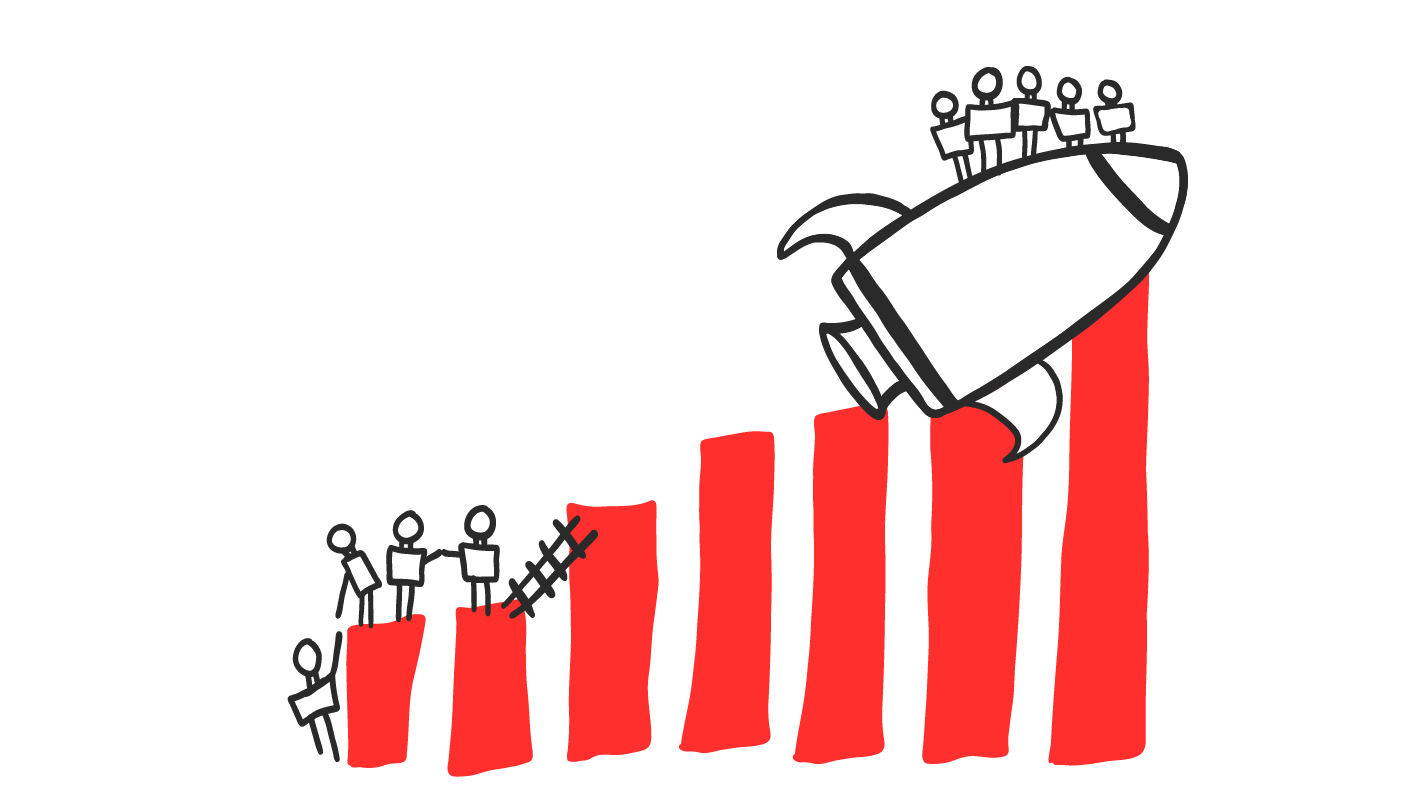“Don’t confuse your mission, your vision, your purpose, with what you sell. At the end of the day, customers really want to know that you’re going to add some kind of value to them. You’re going to help them be faster, smarter, better, more efficient. Yes, your mission and vision are important for attracting the right investors and employees but...you need to really focus on the product to attract customers.”
I keep thinking about these words from growth marketer Robin Daniels. After all, I literally have “write with purpose” tattooed on my arm, so to downplay mission and vision is a bit tough for me to swallow. Then I thought of notorious Enron’s espoused values of respect, integrity, communication and excellence. (Pardon me while I choke on my morning chai and irony.) Mission and vision mean nothing anyway without action.
While we at Container Solutions spend a lot of time talking about psychological safety and the value of people within an organisation, we can’t forget that we are working with products first and foremost. And without that, we can’t help our teams meet the most basic Maslow needs.
So how do you become a product-led organisation? And how do you do it without losing your purpose? And what happens when people really have to become the priority? Read on to learn more about cultivating a product-led mindset, among your people.
What is a Product-Led Organisation?
“I think of product-led as almost the opposite of human-led,” Todd Olson told me. As CEO and co-founder of Pendo, a platform to help companies power their product-led journey, this statement shouldn’t have come as such a surprise. But, we really did just come out of a year-long, greedy battle for tech talent—it’s bound to make us believe in the power of an individual tech worker.
Citing Tesla as a prime example of getting a perfect customer experience without ever having to talk to a Tesla employee, Olson argues that great customer experience is about taking the human out of the loop.
Of course, not everyone would agree with this argument, but regardless of whether solely through data and processes or also through human interactions, understanding your customer and what they need is necessarily central to any successful business. Apple offers excellent self-service via the internet, but its “geniuses” provide a unique retail and support experience in store, as well as strong telephone support. BMW prides itself not only on self-service but also the quality of its garages and sales teams. Likewise we know that the key to accessibility and inclusion comes with building products alongside the intended users.
Writing for Business & Decision, Gerrit Denayer suggests that “companies like Uber, Tesla, Apple, Amazon, Netflix, or BMW do not sell a product, but they sell user experience. This experience must be consistent across all the touchpoints and channels with the future customers or brand ambassadors.” What he predicted in 2017 has come to fruition in his 2022 article update:
- Expectations of 24/7 customer support
- Broad desire for self-service
- Increasingly sophisticated chatbots, backed by machine learning
- Still a human in the loop for about 30% of cases
Olson told WTF that he has observed these emerging customer demands in multiple B2C tech companies. A lot of B2B tech companies, however, are still lagging behind the product-led trend. “If you’re selling to the U.S. government, you probably are not a product-led business,” he said. Or if you are any product of a certain size, complexity and customisation—like an ERP or CRM—that has a whole consultant industry around it, you “typically weren’t product led in the past, but many are trying now,” he continued.
Why would you want to be a product-led organisation? Olson says it makes for a more efficient business model “to sell and service your products without relying on humans.” Also as we are likely entering a global recession, organisations are trying to save money and do more with the same or fewer team members.
“A lot of end users and customers want more of a product-led experience. They don’t want to talk to humans,” he explained, calling it “meeting the customer where they are,” which, he argues, as we approach 2023, is usually online.
The Pendo team has quantified the benefits of being a product-led organisation as:
- 5% increase in customer retention
- 15% in net revenue retention
- 30% increase in qualified leads
- 27% reduction in user onboarding time
- 30% faster customer feedback
Becoming a Product-Led Business
Like all good things in tech, it’s an iterative process. “Companies start with areas of the business where they could create a good product experience,” Olson said. Usually the support or onboarding areas are ripe for a better experience and are often costly to run. As with all things in almost 2023, personalisation is part of that expected experience—which done manually might blow your budget. Instead, it’s about a blend of analytics and hyper-contextual content, which comes from tracking how users are finding your product and then engaging with them across mobile, website and application, “leveraging product data to personalise that experience,” Olson explained. Pendo achieves this with a mix of machine learning and in-depth workflows and paths to buying.
This can’t be a bottom-up initiative, he argues. “For any sort of transformational change, you need a leader,” often the role of product-led or growth leader. Once that person communicates the organisation’s pivot, they build a cross-functional growth team that includes a project manager, some engineers, and a designer. He says this team must work closely with marketing who best know how to communicate with the customers.
This is an evolution of the project manager role. It’s not often the skillset of a typical Scrum team or Product Owner, however Olson says it should be. Every org would benefit from PMs being more focused on data integration and experimentation, and on working cross-functionally—especially with marketing.
A good way to start to get everyone on board is by gathering and sharing important data using things like your product’s Net Promoter Score (NPS.) “It’s one thing to know someone is using something, it’s another thing to know that they are happy,” he said.
After customer support teams, sales is the next logical place to make more product led and self service orientated. “Those jobs get repurposed into higher value activities,” he explained, like “Sales teams selling to some portion of the market that still wants to talk to a sales team,” such as governments and those that are focused on security and privacy.
He pointed to Calendly as a very product-led B2B company that only recently started adding a sales team to focus on larger companies that already have pockets of users.
Progressive delivery is also critically important to a product-led organisation. Coined by Redmonk’s James Governor, who says: “Progressive delivery is continuous delivery with fine-grained control over the blast radius.” It’s an umbrella term for any combination of user segmentation, traffic management, observability and automation, that intentionally releases and basically tests in production any changes on a specified fraction of users. This can include canary testing, blue-green deployments and A/B testing, feature flagging, and Service Mesh.
“When you have product-led growth, you want to measure an outcome,” which means being able to turn experiments on and off, which in turn, Olson says, reduces support tickets.
A Cloud Native mindset and technical stack drives all this. “Cloud allows you to be more iterative because you typically release faster and more often to customers,” he continued.
Finally, call us biassed, but what about the engineers? There’s definitely still plenty of work for them as they drive this continuous experimentation and improvement. “A product-led engineering team doesn’t assume that humans are going to be the ones that drive the engagement of their product. The product itself has to be a good enough experience to drive engagement.” Olson continued that product-led engineers have a certain bias towards user experience and building to educate people how to use a product the right way.
Staying Product Led in the Midst of a War
“We aim to become a cosy harbour where our clients can find tech support and successfully deliver their products to the market. Our key mission is to make these products accessible, functional, user-friendly, and attractive.”
Code Harbor’s mission statement, while still cosy, is interestingly less esoteric than Enron’s and really focuses on being a product-led IT consultancy for product-led tech companies. “We are trying to dive deep into our customers' issues, analysing their business processes to reveal their real needs,” Sviatoslav S., Code Harbor's CEO, told me.
The Code Harbor team validates requirements using the five-W questions, focusing on customer needs, not just wants:
- Who is it about?
- What happened?
- When did it take place?
- Where did it take place?
- Why did it happen?
“If the client or product stakeholders clearly understand how required features will assist their business goals – we accept such requirements. If not, we work with a client on a set of features that will have a clear definition of ‘why?’ and ‘what for?’” Sviatoslav explained.
He offered the example of a SaaS electronic signature tool that wanted to implement social features like forums and private chats, which was well outside the scope of their existing business model. His team rejected those feature requests and scheduled an evaluation session to refocus on those W questions. “If we won’t be satisfied with the answers, we’d definitely drive the focus of our client to their users’ needs,” he said.
Sviatoslav actually calls this “customer-first”, because it’s about building a process where their customers focus on their respective users, before prioritising the product next.
But how can you remain product- or customer-first when the world is crumbling around you? Like more than 8,000 tech companies, Code Harbor is based in Ukraine, which was illegally invaded by Russia last February. “Yes, war is a powerful distracting factor,” Sviatoslav admits. However, for the distributed, remote-first team, after relocating from Kyiv to Western Ukraine and surrounding countries, it’s been mostly business as usual, so long as the electricity and internet connection stays on.
But their mission and drive has grown to include a greater emphasis on corporate social responsibility (CSR.) “There are more reasons to operate now,” he said. “The purpose of operations is also to support our employees’ families, relatives, and friends. Keep going and supporting our country with donations and equipment for AFU—the Armed Forces of Ukraine.” A product-led mindset has just enabled them to keep their customers—and, most importantly, their customers’ customers—happy in unimaginable times.
In the end, I’m only semi-convinced about the term product-led organisation. The people and purpose are still what keep them going after all.


 Previous article
Previous article
